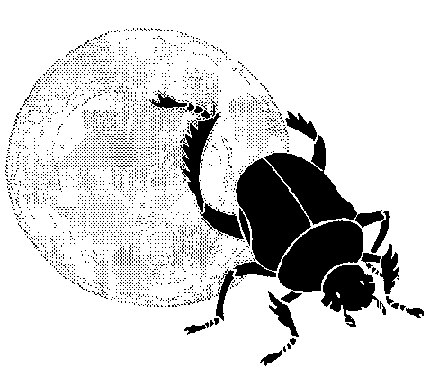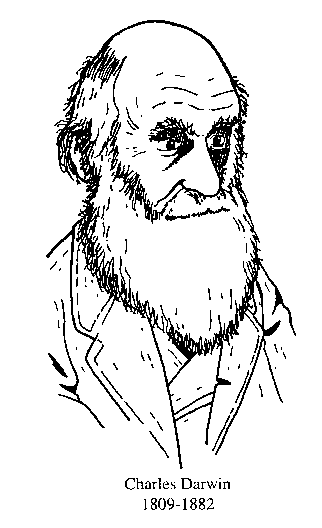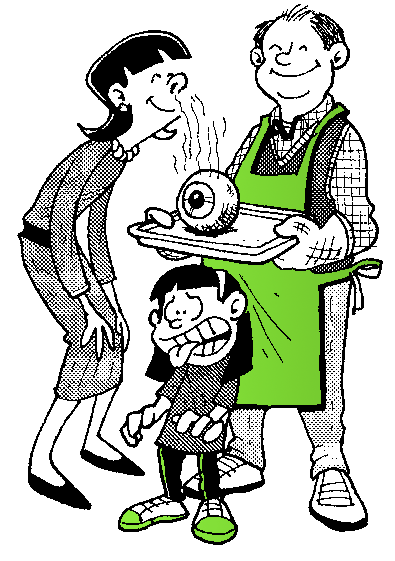

































"I have called this principle, by which each slight
variation, if useful, is preserved, by the term Natural
Selection "
- Charles Darwin, from On the Origin of Species
“How extremely stupid for me not to have thought of
that! ”
- T. H. Huxley on reading On the Origin of Species
The ancient Egyptians believed that a dung beetle rolled the sun across the sky everyday. Having observed the daily movements of the sun and the activities of a beetle rolling a dung ball, they formulated the hypothesis that a giant beetle pushed the sun in a similar fashion. Since they stopped short of systematically testing this idea, it became their belief, not a scientific explanation.

Science requires a few more steps beyond hypothesis formation. The first is performing experiments to test the idea. Experiments produce results called data that may support or refute a hypothesis. Using a sophisticated telescope and detailed satellite images o f the sun would be one way to test whether a giant beetle (presumably wearing oven mitts) is responsible for old Sol’s daily migration. To date, astronomers haven’t spotted any, and they are now fairly confident that beetles have little to nothing to do with the movement o f celestial bodies. Thus, the data collected refute the giant scarab hypothesis.
Systematically testing hypotheses is one of the primary ways in which scientists attempt to describe the natural world. That process assumes that there are natural explanations for the phenomena that we experience. We now explain the movement o f stars and planets in terms of gravity, inertia, acceleration, rotation and revolution.
Just as scientists have looked for ways to explain the changes in the heavens, they have also looked for ways to explain changes in life on earth. A number of naturalists before Charles Darwin (including his poet grandfather) had suggested that living things evolved over time. But it was not until Darwin proposed a testable mechanism for evolution that the way we view life on earth was changed forever.
From a very early age, Charles Darwin. was a naturalist and experimentalist. He collected bird eggs and beetles. He set up a lab with his brother Erasmus in a shed in their backyard and was nicknamed “Gas’1 for the stinky chemistry experiments he performed in the sleeping 1809-1882 dorm of his boarding school. He noticed things, wrote them down and sought connections and explanations. These skills combined with his robust curiosity and patience would help him revolutionize how scientists viewed life on earth.

Darwin spent five years travelling the world on HMS Beagle as the ship’s naturalist. In that time he had a chance to see a variety of animals living in a wide variety of different climates and ecosystems. This experience gave him a perspective on plant and animal species that few naturalist before him had. After his voyage, he wrote volumes about the specimens he collected and his observations on natural history. From those observations, he formulated a testable hypothesis for how evolution occurs. He called his mechanism Natural Selection, and we can break it into four primary postulates. Darwin felt that evolution can occur if the following conditions exist:
The power of Darwin’s theory is its simplicity. The basic idea is that those with advantages tend to have a better chance of surviving to reproduce and pass their advantageous traits onto the next generation.
When he proposed natural selection in his book On the Origin of Species in 1859, Darwin’s hypothesis faced a critical scientific community ready to challenge the data. Yet, in the 148 years since then, natural selection has survived intense scientific scrutiny and has been experimentally supported innumerable times. When a hypothesis is supported by a substantial amount of accurate data, it is referred to as a theory. Though considered highly reliable, a theory is not set in stone and the possibility always exists that new data might be found that contradicts it. When that happens, the theory in question may need to be revised or completely abandoned.
Although researchers continue to add nuances to evolutionary theory, there has been no compelling evidence to contradict it. Biologists are quite confident that the Theory of Natural Selection explains a fundamental way in which life evolves.
Advantages that increase the long-term probability that an organism will survive to reproduce are referred to as adaptations. Adaptations can be anatomical features like an eye, physiological processes such as the ability of nerves to conduct electrical signals, and behavioral traits like reflexively turning toward a loud sound.
Those organisms with the best adaptations tend to do better in the long-term - the key word here being tend. An advantage is no guarantee of success. Having slightly better eyes than everyone else doesn’t do you much good if you get blind-sided by a bus. Advantage or no, there is a small element of luck (good or bad) tied up in everyone’s survival. But, taking that as a given, having slightly better eyes, a bigger brain or some other advantage can come in handy when you are competing with others for resources such as food and mates.
So where do adaptations come from? How do some organisms get these “slight advantages” we keep mentioning? They start as goof-ups in the DNA called mutations. When animals make their sperm and eggs and plants make their pollen and ova, they have to copy their DNA. In the process, sometimes things are copied incorrectly.
Imagine having to transcribe the contents of your local library. Omissions and misspellings would be inevitable. When these mistakes happen copying DNA, there are three possible outcomes: First, the mistake may be lethal, in which case the embryo will not be viable. Second, the copying error might be neutral. In other words, the change has no effect on the organism. Third, there is the possibility that the mutation will be beneficial.
To consider how a small change in the DNA sequence can alter a gene, it is important to think of genes as bits of information, like sentences. Imagine our gene is the following sentence:
let's make an eye.

Now, we copy it several times and stick it into our sperm and eggs. What happens if we copy one of the letters incorrectly? We might get something that makes no sense, or changes the meaning completely, such as
let's bake an eye.
Or we might get something that is a slight improvement, like
Let's make an eye.
Unfortunately, an organism cannot plan improvements in its genes. Mutations occur randomly. We cannot predict where or when they will pop up. So, how could a random process like this lead to the evolution of an elaborate adaptation like your camera eye? It couldn’t.
If evolution were an exclusively random process, the evolution of sophisticated organisms like beetles and oak trees would be extremely unlikely. But mutation isn’t working alone. Natural selection is its partner. Mutation is a random process that generates the raw material on which natural selection acts in a highly directed fashion.
Consider Darwin’s quote about natural selection: "... Each slight variation, if useful, is preserved.. The flip side of that is that slight variations that are harmful are not preserved. Natural selection is, by definition, selective. The process weeds out what doesn’t work and preserves what does. Sophisticated adaptations like the eye are the product of small incremental improvements in vision that have accumulated over vast amounts of time.
So, how does natural selection pick who stays and who goes? The process relies upon selective agents that apply selective pressures to a population of organisms. Predation in the preceding Wrinkles story was the selective agent. The miniature versions of Wrinkles with better eyes escaped the predators and those with weaker vision did not. Selective pressures can be biotic (living) or abiotic (non-living). Predation is a biotic selective pressure, because predators are living organisms. Climate is an example of an abiotic selective pressure.
Selective pressures sort organisms based on the organisms’ phenotypes. A phenotype is the outward, physical expression of one’s genes. In other words, the phenotype is the body and behavior that an organism’s genes build. Thus, the group of miniature Wrinkles that survived Darwin’s predatory onslaught had slightly different eye phenotypes than those that were eaten. Different phenotypes occur because all organisms have different sets of genes. An organism’s unique set of genes is called its genotype. All genotypes are unique, but closely related organisms (like two humans) have fewer differences between their genotypes than more distantly related organisms (like a human and an earthworm).
Although natural selection exerts pressure on individuals, evolution occurs at the population level. A population is an interbreeding community of organisms. The total genetic information in a population is called a gene pool. When organisms breed, the genes in the gene pool get mixed up and passed onto the next generation. If everybody in the population has the same chance to survive and nobody with new genes migrates in, then the gene pool won’t change much.
In the preceding story, Charles Darwin and Wrinkles the Wonder Brain gobbled up phenotypes with less well-developed eyes in a population, thus removing the genotypes that built those phenotypes. Thus, the genes that code for the less sophisticated eyes will be removed from the population and change the make-up of the gene pool. When the gene pool changes, the types of phenotypes you see in the succeeding generations will change as well.
A change in the genetic make-up of a population from generation to generation is the modem definition of evolution. Consequently we say that populations evolve. Individuals do not evolve. A drowning person cannot grow gills any more than a gazelle fleeing a cheetah can sprout wings and fly away. Thus, evolution is typically a relatively slow process (although populations of organisms like bacteria can evolve quite quickly). If only slight variations are being preserved from generation to generation in a population, then it will take a long time for a population to evolve a sophisticated adaptation like a camera eye. Fortunately, time is on our side.
Deep TimeIf we want small variations to accumulate into big adaptive changes, we are going to need a lot of time. In fact, for evolution by natural selection to occur, we often need millions or billions of years. Early in Darwin’s career, most Western scientists believed that the earth was a little over 6000 years old. That changed when advances in the field of geology in the late 1700s and early 1800s yielded data indicating that the earth was quite a bit older. In the late 18th century, James Hutton advanced a theory called uniformitarianism (which was later expanded upon by Charles Lyell in the book Principles of Geology). Hutton and Lyell proposed that the small geological changes that we witness occurring now (such as the slow deposition or erosion of soil) have been happening for eons and are responsible for the landforms we see. The research of both men indicated that rocks form very slowly and that big geological features like mountains resulted from small incremental changes as geological forces slowly pushed up the earth’s crust. Modem measurements confirm that the plates making up the earth’s crust move 1-17 cm per year. According to data collected by the U.S. Geological Survey, the Himalayan Mountains rise by about 1 cm every year (a pace of about 10km per million years). Current estimates place the earth’s age at approximately 4.5 billion years. This figure has been corroborated by numerous different experiments from geology, chemistry and physics. Such an expansive sweep of time would be more than sufficient to move mountains and allow the critters scurrying on their landscape to evolve gradually. Can’t We Go Any Faster?Not all creatures need loads of time to go through substantial evolutionary changes. Most animals like penguins and tulip trees have generation times that are measured in years. Thus, small changes in a population require considerable time to accumulate. Not so for the most successful living things on earth. Bacteria, which can be found in virtually every conceivable habitat on the planet, deep inside the earth and high in the atmosphere, reproduce by splitting in two and can have very short generation times. The fastest reproducing bacteria can double their numbers in 15 minutes, although most have generation times measured in hours or a day. Thus, small changes in each generation can accumulate quite rapidly. One example of this is seen in the evolution of antibiotic resistance, a growing problem for health care providers (Fig. 2.1). Antibiotics are designed to kill bacteria in a sick person. But if a few of those bacteria have a mutation that protects them from the antibiotic, they might survive and reproduce. Thus, the antibiotic is a selective agent selectively killing some and leaving those with resistance alive. If one continues to expose the bacteria to the antibiotic, one can cause a shift in the genetic make-up of the population, so that most of the bacteria are resistant and the antibiotic is rendered ineffective. |
 Figure 2.1 Small change, big
problem. A) A small mutation
makes a few bacteria in a population
antibiotic resistant (gray
bacteria). B) When antibiotics
are applied, most of the nonresistant
bacteria (white) are
killed and those that are antibiotic
resistant are not. C) As a
result of the treatment, the genetic
make-up of the next generation
has changed and more
resistant bacteria are present.
The evolution of antibiotic resistant
bacteria is a major concern
for health care providers. |
 Figure 2.2 A flat patch of photosensitive tissue becomes a camera eye very rapidly when there is a constant selective pressure for improved ability to form an image. Modified form Nilsson and Pelger (1994) |
|